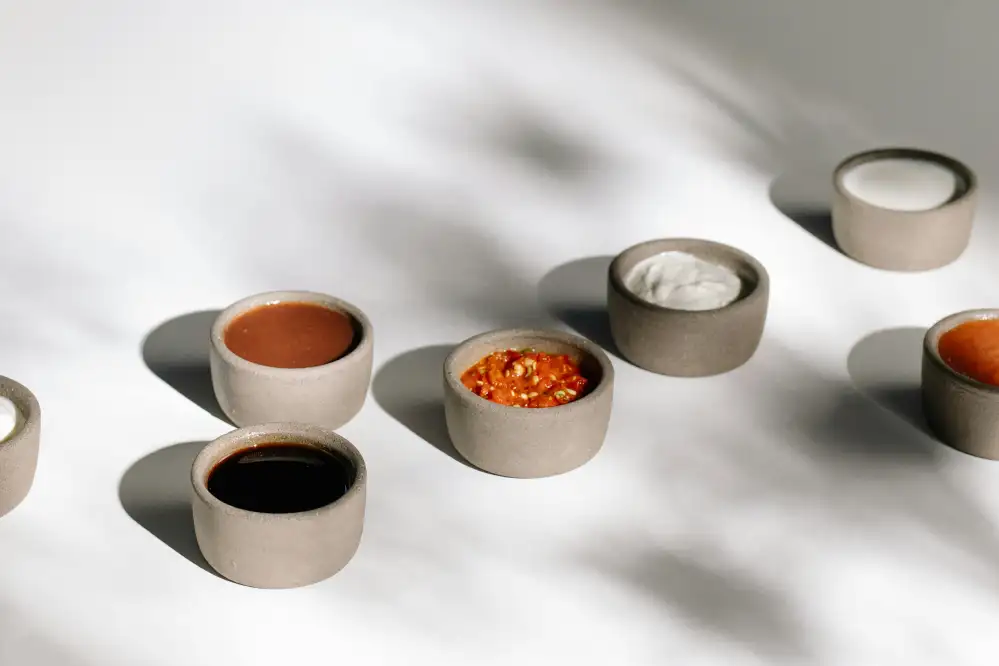Delightful Plum Sauce: Elevate Your Asian Cuisine with this Irresistible Recipe!

- History and Origins of Plum Sauce
- Ingredients Required for Making Plum Sauce
- Step-by-Step Instructions for Making Plum Sauce
- Variations and Adaptations of Plum Sauce
- Popular Dishes that Use Plum Sauce
- Health Benefits of Plum Sauce
- Tips and Tricks for Using Plum Sauce in Cooking
- Storing and Shelf Life of Plum Sauce
Plum sauce is a delectable condiment that adds a burst of flavor to Asian cuisine. It is a versatile sauce that can be used as a dip, glaze, or marinade. With its sweet and tangy taste, plum sauce perfectly complements dishes such as spring rolls, dumplings, and roasted meats.
This delightful sauce has been enjoyed for centuries and is believed to have originated in China. It has since spread throughout Asia and gained popularity worldwide. Plum sauce is made from ripe plums that are cooked down with various spices and seasonings to create a rich and flavorful sauce.
In this article, we will explore the history and origins of plum sauce, the ingredients required for making it, step-by-step instructions for preparing it at home, popular dishes that use plum sauce, its health benefits, tips and tricks for using it in cooking, as well as storing and shelf life information. Get ready to elevate your Asian cuisine with this irresistible homemade plum sauce!
History and Origins of Plum Sauce
Plum sauce, also known as plum jam or plum paste, has a rich history that dates back centuries. Its origins can be traced to ancient China, where plums were highly revered for their medicinal properties and culinary uses.
The earliest records of plum sauce can be found in Chinese texts from the Tang Dynasty (618-907 AD). During this time, plums were commonly used in traditional Chinese medicine to aid digestion and promote overall health. It was believed that the tangy and sweet flavor of plums could balance the body's yin and yang energies.
As trade routes expanded during the Song Dynasty (960-1279 AD), plum sauce began to gain popularity beyond China's borders. It made its way to other parts of Asia, including Japan and Korea, where it became an essential condiment in their cuisines.
In Japan, plum sauce is known as "umeboshi" and is made from pickled plums. Umeboshi has a salty and sour taste and is often used as a seasoning or filling for various dishes. In Korea, plum sauce is called "maesil-cheong" and is made by boiling green plums with sugar. Maesil-cheong is commonly used as a dipping sauce or marinade for meat dishes.
Today, plum sauce has become a staple in Asian cuisine worldwide. It is not only used as a condiment but also as an ingredient in various recipes. Its sweet and tangy flavor adds depth to stir-fries, glazes for meats, dipping sauces, and even salad dressings.
The history of plum sauce showcases its versatility and adaptability across different cultures. From its humble beginnings in ancient China to its widespread use today, plum sauce continues to delight palates around the world with its unique blend of flavors.
Ingredients Required for Making Plum Sauce
To make your own delicious plum sauce, you will need a few key ingredients. The star of the show, of course, is fresh plums. Look for ripe plums that are slightly soft to the touch and have a sweet fragrance. You will also need sugar to balance out the tartness of the plums and give the sauce its delightful sweetness.
To add depth and complexity to the flavor, you will need some vinegar. Rice vinegar or apple cider vinegar work well in this recipe. Additionally, you will need some soy sauce to give the sauce a savory umami flavor.
To spice things up, gather some ginger and garlic. These aromatic ingredients will provide a subtle heat and enhance the overall taste of the sauce. Finally, you will need some water to help achieve the desired consistency.
By combining these simple yet flavorful ingredients, you can create a homemade plum sauce that is sure to elevate your Asian cuisine to new heights!
Step-by-Step Instructions for Making Plum Sauce
1. Start by gathering the necessary ingredients: 2 cups of fresh plums (pitted and chopped), 1 cup of sugar, 1/2 cup of rice vinegar, 1/4 cup of soy sauce, 2 cloves of garlic (minced), 1 teaspoon of ginger (grated), and a pinch of red pepper flakes.
2. In a medium-sized saucepan, combine the plums, sugar, rice vinegar, soy sauce, garlic, ginger, and red pepper flakes.
3. Place the saucepan over medium heat and bring the mixture to a boil. Reduce the heat to low and let it simmer for about 30 minutes until the plums are soft and the sauce has thickened.
4. Using an immersion blender or a regular blender, puree the mixture until smooth. If you prefer a chunkier texture, you can skip this step.
5. Return the pureed mixture to the saucepan and continue cooking over low heat for another 10-15 minutes to allow the flavors to meld together.
6. Taste the plum sauce and adjust the seasoning according to your preference. You can add more sugar for sweetness or more soy sauce for saltiness.
7. Once you're satisfied with the taste, remove the plum sauce from heat and let it cool completely before transferring it to a jar or bottle.
8. Store your homemade plum sauce in the refrigerator for up to two weeks. It will thicken further as it cools.
By following these simple steps, you can create your own delicious plum sauce that will elevate your Asian cuisine to new heights!
Variations and Adaptations of Plum Sauce
Plum sauce is a versatile condiment that can be customized to suit different tastes and culinary preferences. While the traditional recipe calls for plums, sugar, vinegar, and spices, there are several variations and adaptations of this delicious sauce.
One popular variation is adding other fruits such as apricots or peaches to the plum sauce. This adds a subtle sweetness and enhances the overall flavor profile. Additionally, some recipes include ingredients like ginger, garlic, or chili peppers to give the sauce a spicy kick.
For those looking for a healthier option, there are recipes that use natural sweeteners like honey or maple syrup instead of sugar. These alternatives not only reduce the calorie content but also add a unique depth of flavor.
Another adaptation of plum sauce is incorporating different spices and herbs. Star anise, cinnamon, cloves, or even fresh herbs like basil or mint can be added to create a more complex taste. These variations allow you to experiment with different flavor combinations and make the sauce your own.
Furthermore, plum sauce can be adapted to suit dietary restrictions. For those following a gluten-free diet, using tamari instead of soy sauce ensures that the sauce remains gluten-free. Similarly, for vegetarians or vegans, replacing fish sauce with soy sauce or miso paste provides an alternative without compromising on taste.
With these variations and adaptations, plum sauce can be tailored to complement various dishes beyond Asian cuisine. It can be used as a glaze for grilled meats or vegetables, as a dipping sauce for spring rolls or dumplings, or even as a marinade for stir-fries.
By exploring these different options and experimenting with flavors, you can elevate your culinary creations and add your personal touch to this delightful condiment.
Popular Dishes that Use Plum Sauce
Plum sauce is a versatile condiment that adds a burst of flavor to various Asian dishes. One popular dish that incorporates plum sauce is Peking duck, a traditional Chinese delicacy. The succulent roasted duck is served with thin pancakes, scallions, cucumber, and a generous drizzle of tangy plum sauce.
Another well-known dish is sweet and sour pork. The crispy battered pork is tossed in a vibrant sweet and sour sauce that often includes plum sauce as one of the key ingredients. This combination of flavors creates a perfect balance between the sweetness of the sauce and the savory notes of the pork.
Plum sauce also pairs exceptionally well with spring rolls and dumplings. These delectable appetizers are typically served with a dipping sauce made from plum sauce, soy sauce, rice vinegar, and chili flakes. The fruity undertones of the plum sauce complement the savory fillings perfectly.
Additionally, plum sauce can be used as a glaze for grilled or roasted meats such as chicken or ribs. Its sticky consistency caramelizes beautifully on the surface, creating a mouthwatering glaze that enhances both the appearance and taste of the dish.
With its versatility and unique flavor profile, plum sauce has become a beloved ingredient in many Asian cuisines. Its ability to elevate both sweet and savory dishes makes it an essential component in numerous recipes across different cultures.
Health Benefits of Plum Sauce
Plum sauce not only adds a burst of flavor to your Asian dishes but also offers several health benefits. Made from plums, this sauce is packed with essential nutrients. Plums are rich in vitamins A, C, and K, as well as dietary fiber. These nutrients support a healthy immune system, promote good vision, and aid in digestion.
Plums are also a great source of antioxidants, which help protect the body against free radicals and reduce the risk of chronic diseases such as heart disease and cancer. Additionally, plum sauce contains natural sugars that provide a quick energy boost.
Furthermore, plums are known for their high water content, making plum sauce a hydrating choice. The sauce also has low-calorie content compared to other condiments like mayonnaise or ketchup.
However, it's important to note that store-bought plum sauces may contain added sugars and preservatives. To maximize the health benefits of plum sauce, consider making your own at home using fresh plums and minimal additional ingredients.
Incorporating plum sauce into your meals can be a delicious way to enhance both the taste and nutritional value of your dishes. So why not give it a try and enjoy the health benefits it has to offer?
Tips and Tricks for Using Plum Sauce in Cooking
1. Marinade: Use plum sauce as a marinade for meats like chicken, pork, or even tofu. The sweet and tangy flavors will infuse into the meat, making it tender and flavorful.
2. Stir-fry: Add a spoonful of plum sauce to your stir-fried vegetables or noodles for an extra burst of flavor. It adds a delicious sweetness that complements the savory ingredients.
3. Glaze: Brush plum sauce onto grilled or roasted meats during the last few minutes of cooking. The heat caramelizes the sugars in the sauce, creating a sticky glaze that enhances the taste and appearance of your dish.
4. Dipping Sauce: Serve plum sauce as a dipping sauce alongside spring rolls, dumplings, or crispy wontons. Its unique combination of sweet and sour flavors pairs perfectly with these appetizers.
5. Salad Dressing: Mix plum sauce with vinegar, oil, and a touch of soy sauce to create a delightful dressing for salads. It adds a fruity twist that elevates your greens to another level.
6. Pizza Topping: Spread a thin layer of plum sauce on your pizza crust before adding toppings like grilled chicken, red onions, and mozzarella cheese. It brings an unexpected but delicious flavor profile to your favorite comfort food.
Remember to adjust the amount of plum sauce according to your taste preferences as it can be quite strong in flavor. Experiment with different combinations to discover new culinary delights!
Storing and Shelf Life of Plum Sauce
Published: 11. 02. 2024
Category:
Recipes
Published: 11. 02. 2024
Category: Recipes



